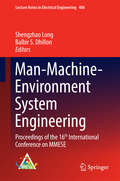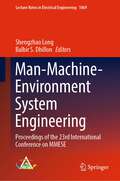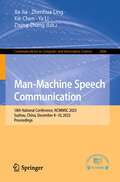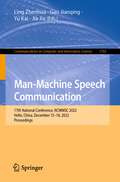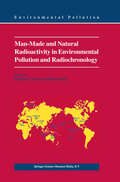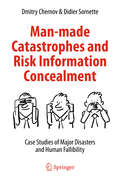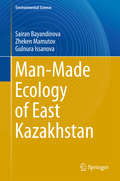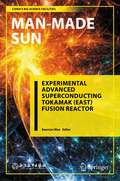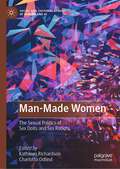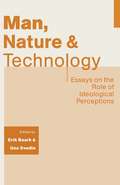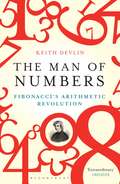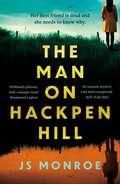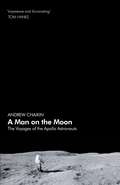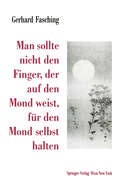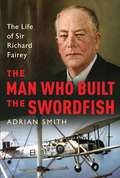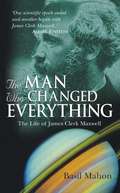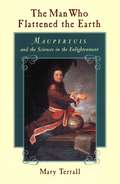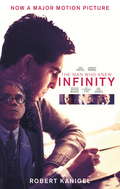- Table View
- List View
Man-Machine-Environment System Engineering: Proceedings of the 16th International Conference on MMESE (Lecture Notes in Electrical Engineering #406)
by Shengzhao Long Balbir S. DhillonThis research topic was first established in China by Professor Shengzhao Long in 1981, with direct support from one of the greatest modern Chinese scientists, Xuesen Qian. In a letter to Shengzhao Long from October 22nd, 1993, Xuesen Qian wrote: “You have created a very important modern science subject and technology in China!”MMESE primarily focuses on the relationship between Man, Machine and Environment, studying the optimum combination of man-machine-environment systems. In this system, “Man” refers to working people as the subject in the workplace (e.g. operators, decision-makers); “Machine” is the general name for any object controlled by Man (including tools, machinery, computers, systems and technologies), and “Environment” describes the specific working conditions under which Man and Machine interact (e.g. temperature, noise, vibration, hazardous gases etc.). The three goals of optimization are to ensure "Safety, High efficiency and Economy" of man-machine-environment systems.These proceedings are an academic showcase of the best papers selected from more than 400 submissions, introducing readers to the top research topics and the latest developmental trends in the theory and application of MMESE.These proceedings are interdisciplinary studies on the concepts and methods of physiology, psychology, system engineering, computer science, environment science, management, education, and other related disciplines. Researchers and professionals who study an interdisciplinary subject crossing above disciplines or researchers on MMESE subject will be mainly benefited from these proceedings.
Man-Machine-Environment System Engineering: Commemorative Conference for the 110th Anniversary of Xuesen Qian’s Birth and the 40th Anniversary of Founding of Man-Machine-Environment System Engineering (Lecture Notes in Electrical Engineering #800)
by Shengzhao Long Balbir S. DhillonMan-Machine-Environment System Engineering: Proceedings of the 21st Conference on MMESE is the academic showcase of best research papers selected from more than 500 submissions each year. From this book reader will learn the best research topics and the latest development trend in MMESE design theory and other human-centered system application.MMESE focus mainly on the relationship between Man, Machine and Environment. It studies the optimum combination of man-machine-environment systems. In the system, the Man means the working people as the subject in the workplace (e.g. operator, decision-maker); the Machine means the general name of any object controlled by the Man (including tool, Machinery, Computer, system and technology), the Environment means the specially working conditions under which Man and Machine occupy together(e.g. temperature, noise, vibration, hazardous gases etc.). The three goals of the optimization of the system are safety, efficiency and economy.In 1981 with direct support from one of the greatest modern Chinese scientists, Qian Xuesen, Man-Machine-Environment System Engineering (MMESE), the integrated and advanced science research topic was established in China by Professor Shengzhao Long. In the letter to Shengzhao Long, in October 22nd, 1993, Qian Xuesen wrote: “You have created a very important modern science subject and technology in China!”.
Man-Machine-Environment System Engineering: Proceedings of the 23rd International Conference on MMESE (Lecture Notes in Electrical Engineering #1069)
by Shengzhao Long Balbir S. DhillonMan-Machine-Environment System Engineering: Proceedings of the 23rd Conference on MMESE are an academic showcase of the best papers selected from more than 500 submissions, introducing readers to the top research topics and the latest developmental trends in the theory and application of MMESE. This proceedings are interdisciplinary studies on the concepts and methods of physiology, psychology, system engineering, computer science, environment science, management, education, and other related disciplines. Researchers and professionals who study an interdisciplinary subject crossing above disciplines or researchers on MMESE subject will be mainly benefited from this proceedings.MMESE primarily focuses on the relationship between Man, Machine and Environment, studying the optimum combination of man-machine-environment systems. In this system, “Man” refers to working people as the subject in the workplace (e.g. operators, decision-makers); “Machine” is the general name for any object controlled by Man (including tools, machinery, computers, systems and technologies), and “Environment” describes the specific working conditions under which Man and Machine interact (e.g. temperature, noise, vibration, hazardous gases etc.). The three goals of optimization of the man-machine-environment systems are to ensure safety, efficiency and economy.The integrated and advanced science research topic Man-Machine-Environment System Engineering (MMESE) was first established in China by Professor Shengzhao Long in 1981, with direct support from one of the greatest modern Chinese scientists, Xuesen Qian. In a letter to Shengzhao Long from October 22nd, 1993, Xuesen Qian wrote: “You have created a very important modern science and technology in China!”
Man-Machine Interactions (Advances in Intelligent and Soft Computing #59)
by James F. Peters Urszula Stanczyk Alicja Wakulicz-Deja Krzysztof A. Cyran Stanislaw KozielskiMan-Machine Interactions 2 (Advances in Intelligent and Soft Computing #103)
by Tadeusz Czachorski Stanislaw Kozielski Urszula StanczykMan-machine interaction is the interdisciplinary field, focused on a human and a machine in conjunction. It is the intersection of computer science, behavioural sciences, social psychology, ergonomics, security. It encompasses study, design, implementation, and evaluation of small- and large-scale, interacting, computing, hardware and software systems dedicated for human use. Man-machine interaction builds on supportive knowledge from both sides, the machine side providing techniques, methods and technologies relevant for computer graphics, visualisation, programming environments, the human side bringing elements of communication theory, linguistics, social sciences, models of behaviour. The discipline aims to improve ways in which machines and their users interact, making hardware and software systems better adapted to user's needs, more usable, more receptive, and optimised for desired properties. This monograph is the second edition in the series, providing the reader with a selection of high-quality papers dedicated to current progress, new developments and research trends in man-machine interactions area. In particular, the topical subdivisions of this volume include human-computer interfaces, robot control and navigation systems, bio-data analysis and mining, pattern recognition for medical applications, sound, text and image processing, design and decision support, rough and fuzzy systems, crisp and fuzzy clustering, prediction and regression, algorithms and optimisation, and data management systems.
Man-Machine Speech Communication: 18th National Conference, NCMMSC 2023, Suzhou, China, December 8–10, 2023, Proceedings (Communications in Computer and Information Science #2006)
by Jia Jia Zhenhua Ling Xie Chen Ya Li Zixing ZhangThis book constitutes the refereed proceedings of the 18th National Conference on Man-Machine Speech Communication, NCMMSC 2023, held in Suzhou, China, during December 8–11, 2023.The 20 full papers and 11 short papers included in this book were carefully reviewed and selected from 117 submissions. They deal with topics such as speech recognition, synthesis, enhancement and coding, audio/music/singing synthesis, avatar, speaker recognition and verification, human–computer dialogue systems, large language models as well as phonetic and linguistic topics such as speech prosody analysis, pathological speech analysis, experimental phonetics, acoustic scene classification.
Man-Machine Speech Communication: 14th National Conference, NCMMSC 2017, Lianyungang, China, October 11–13, 2017, Revised Selected Papers (Communications in Computer and Information Science #807)
by Jianhua Tao Thomas Fang Zheng Changchun Bao Dong Wang Ya LiThis book constitutes the refereed proceedings of the 14th National Conference on Man-Machine Speech Communication, NCMMSC 2017, held in Lianyungang, China, in October 2017. The 13 revised full papers presented were carefully reviewed and selected from 39 submissions. The papers address issues such as challenging issues in speech recognition and enhancement, speaker and language recognition, speech synthesis, corpus and phonetic in speech technology, speech generation, speech analyzing and modelling, speech processing of ethnic minorities, speech emotion recognition and audio signal processing.
Man-Machine Speech Communication: 17th National Conference, NCMMSC 2022, Hefei, China, December 15–18, 2022, Proceedings (Communications in Computer and Information Science #1765)
by Ling Zhenhua Gao Jianqing Yu Kai Jia JiaThis book constitutes the refereed proceedings of the 17th National Conference on Man–Machine Speech Communication, NCMMSC 2022, held in China, in December 2022.The 21 full papers and 7 short papers included in this book were carefully reviewed and selected from 108 submissions. They were organized in topical sections as follows: MCPN: A Multiple Cross-Perception Network for Real-Time Emotion Recognition in Conversation.- Baby Cry Recognition Based on Acoustic Segment Model, MnTTS2 An Open-Source Multi-Speaker Mongolian Text-to-Speech Synthesis Dataset.
Man-Made and Natural Radioactivity in Environmental Pollution and Radiochronology (Environmental Pollution #7)
by Richard Tykva Dieter BergThe goal of this book is to examine the complex state of radioactivity in the environment, and to understand the interplay of its two principal sources: man-made and natural. The text examines human contributions to release of radionuclides, with an eye to future reductions, and assesses natural occurrences in an evaluation of baseline radioactivity.
Man-made Catastrophes and Risk Information Concealment: Case Studies of Major Disasters and Human Fallibility
by Dmitry Chernov Didier SornetteThis book discusses the risks of information concealment in the context of major natural or industrial disasters – offering detailed descriptions and analyses of some 25 historical cases (Three Mile Island nuclear accident, Bhopal disaster, Challenger Space Shuttle explosion, Chernobyl nuclear disaster, Deepwater Horizon oil spill, Fukushima-Daiichi nuclear disaster, Enron’s bankruptcy, Subprime mortgage crisis, Worldwide Spanish flu and SARS outbreaks, etc.) and applying these insights to selected on-going cases where such information concealment is suspected. Some successful examples of preventive anti-concealment practice are also presented.In the book, the term ‘concealment’ is used to represent the two distinct behaviors uncovered in the investigations: (i) facts and information about an organization and its functioning being hidden from those that need them – here the concealment can be due to various factors, such as complexity and miscommunication, to name but two – and (ii) the conscious and deliberate action of keeping important information secret or misrepresenting it. This second meaning makes up a surprisingly important part of the evidence presented. Accordingly, emphasis has been put on this second aspect and the approach is more pragmatic than academic, remaining focused on evidence-based practical and useful factors. It raises awareness and provides valuable lessons for decision- makers, risk specialists and responsible citizens alike. This work is also intended as a fact-based reference work for future academic and scholarly investigations on the roots of the problem, in particular regarding any psychological or sociological modeling of human fallibility.
Man-Made Ecology of East Kazakhstan (Environmental Science and Engineering)
by Sairan Bayandinova Zheken Mamutov Gulnura IssanovaThis book highlights studies of differentiation problems of natural geosystems because of anthropogenic impact. The systematic methodology of comprehensive ecological assessment of anthropogenic impact on natural geosystems and their differentiations on the level of technogenic conditionality for ensuring rational environmental management and environmental protection are discussed. The practical importance of this book lies in the evidence-based recommendations and actions for conservation and quality management of the environment in order to decrease the degree of anthropogenic impact and in prevention of degradation processes. The book is useful to the researchers, industrial, scientific, and other organizations in establishing the purpose of the problem and solution to environmental protection and rational environmental management.
Man-Made Sun: Experimental Advanced Superconducting Tokamak (EAST) Fusion Reactor (China’s Big Science Facilities)
by Baonian WanThis book introduces the research process and principles of the controlled super-coupling nuclear fusion experiment at the Experimental Advanced Superconducting Tokamak (EAST) nuclear fusion reactor in Hefei, China. It uses straightforward language to explain how nuclear fusion can provide safe, environmentally friendly, clean, and inexhaustible energy in future. EAST is the world’s first fully superconducting, non-circular cross-section tokamak nuclear fusion experimental device, independently developed by the Chinese Academy of Sciences. This book helps demonstrate China’s cutting-edge scientific and technological advances to the rest of the world, helps spread the scientific spirit to people around the globe, and promotes prosperity and development. The book is intended for all non-experts who would like to learn more about nuclear energy and related technologies.
Man-Made Women: The Sexual Politics of Sex Dolls and Sex Robots (Social and Cultural Studies of Robots and AI)
by Kathleen Richardson Charlotta OdlindThis book presents a unique, feminist approach to ‘sex’ dolls and ‘sex’ robots, taking a critical look at the academic and business narratives that serve to rationalise them. As new forms of pornography (porn robots), this edited volume provides an urgent women’s centred critique. The emergence of ‘sex’ robots is situated within the wider context of the attack on women’s rights and the relentless rise of techno-pornography. As an outgrowth of the industries of prostitution, pornography and child sex abuse, these objects offer new ways to dehumanise women and girls. While support for ‘sex’ robots is positioned as progressive and emancipatory, the contributors in this volume argue they reduce women to consumable parts. They explore how law, the arts, ethics, economy, politics and culture are interconnected with harmful technological developments.
The Man of Numbers: Fibonacci's Arithmetic Revolution
by Keith DevlinIn 1202, a 32-year old Italian finished one of the most influential books of all time, which introduced modern arithmetic to Western Europe. Devised in India in the seventh and eighth centuries and brought to North Africa by Muslim traders, the Hindu-Arabic system helped transform the West into the dominant force in science, technology, and commerce, leaving behind Muslim cultures which had long known it but had failed to see its potential. The young Italian, Leonardo of Pisa (better known today as Fibonacci), had learned the Hindu number system when he traveled to North Africa with his father, a customs agent. The book he created was Liber abbaci, the 'Book of Calculation', and the revolution that followed its publication was enormous. Arithmetic made it possible for ordinary people to buy and sell goods, convert currencies, and keep accurate records of possessions more readily than ever before. Liber abbaci's publication led directly to large-scale international commerce and the scientific revolution of the Renaissance. Yet despite the ubiquity of his discoveries, Leonardo of Pisa remains an enigma. His name is best known today in association with an exercise in Liber abbaci whose solution gives rise to a sequence of numbers - the Fibonacci sequence - used by some to predict the rise and fall of financial markets, and evident in myriad biological structures. In The Man of Numbers, Keith Devlin recreates the life and enduring legacy of an overlooked genius, and in the process makes clear how central numbers and mathematics are to our daily lives.
The Man on Hackpen Hill
by J.S. Monroe'Brilliantly plotted, with a seismic twist' Rosamund LuptonHer best friend is dead and she needs to know why.Aspiring journalist Bella is on work experience at a national newspaper when, out of the blue, she receives an anonymous letter promising her a big scoop if she travels down to Wiltshire.All she finds is a government scientist spouting conspiracy theories in the pub. But then Bella's best friend Erin is found dead in a nearby field, her body staged in the centre of a crop circle. Bella is devastated. Is this the real reason she was lured out here?While detective Silas Hart searches for evidence, Bella scours her own memory for clues. But it's full of blanks – the details of her university days with Erin keep slipping away. What secrets was Erin hiding? And, once they're uncovered, what will it mean for Bella?Praise for The Man on Hackpen Hill:'An impressive, twisty tale' Independent 'Impeccably researched... An unusual mystery told with exceptional skill' Daily Mail 'A kind of Wiltshire Da Vinci Code... A real page turner' Tom Bradby
A Man on the Moon: The Voyages of the Apollo Astronauts (A\man On The Moon Ser.)
by Andrew Chaikin'IMPRESSIVE AND ILLUMINATING' TOM HANKS This is the definitive account of the heroic Apollo programme. When astronauts Neil Armstrong and Buzz Aldrin took their 'giant leap for mankind' across a ghostly lunar landscape, they were watched by some 600 million people on Earth 240,000 miles away.Drawing on hundreds of hours of in-depth interviews with the astronauts and mission personnel, this is the story of the twentieth century's greatest human achievement, minute-by-minute, through the eyes of those who were there.From the tragedy of the fire in Apollo 1 during a simulated launch, Apollo 8's bold pioneering flight around the moon, through to the euphoria of the first moonwalk, and to the discoveries made by the first scientist on the moon aboard Apollo 17, this book covers it all. 'An extraordinary book . . . Space, with its limitless boundaries, has the power to inspire, to change lives, to make the impossible happen. Chaikin's superb book demonstrates how' Sunday Times 'A superb account . . . Apollo may be the only achievement by which our age is remembered a thousand years from now' Arthur C. Clarke 'The authoritative masterpiece' Los Angeles Times
Man sollte nicht den Finger, der auf den Mond weist, für den Mond selbst halten
by Gerhard FaschingEine buddhistische Parabel lehrt uns, daß man nicht den Finger, der auf den Mond weist, für den Mond selbst halten sollte. Und trotzdem halten wir oft das Bild, das die Naturwissenschaft zeichnet, für die einzig legitime Art, wie man die Wirklichkeit sehen kann. Im naturwissenschaftlichen Sinn zu wissen heißt, mit einer bestimmten Methode Phänomene sichtbar zu machen. Methoden sind aber nichts absolut Vorgegebenes: Andere Methoden greifen anderes auf und das ursprüngliche Bild wandelt sich. Man darf sich also nicht täuschen lassen: Die Naturwissenschaft zeigt nicht die Wirklichkeit "wie sie ist”. Auf methoden-relative Weise baut sie eher ein Luftschloß mit tausend Details, Details, die alle ineinander passen. Das Publikum steht sprachlos vor diesem bewundernswerten Bau. Unvorstellbar erscheint es, daß alles auch ganz anders aussehen könnte.
The Man Who Built the Swordfish: The Life of Sir Richard Fairey, 1887-1956
by Adrian SmithSir Richard Fairey was one of the great aviation innovators of the twentieth century. His career as a plane maker stretched from the Edwardian period to the jet age - he lived long enough to see one of his aircraft be the first to break the 1000mph barrier; and at least one of his designs, the Swordfish, holds iconic status. A qualified engineer, party to the design, development, and construction of the Royal Navy's state-of-the-art sea planes, Sir Richard founded Fairey Aviation at the Admiralty's behest in 1915. His company survived post-war retrenchment to become one of Britain's largest aircraft manufacturers. The firm built a succession of front-line aircraft for the RAF and the Fleet Air Arm, including the iconic Swordfish. In addition, Fairey Aviation designed and built several cutting-edge experimental aircraft, including long-distance record-breakers between the wars and the stunningly beautiful Delta 2, which broke the world speed record on the eve of Sir Richard's death in 1956. Fairey also came to hold a privileged position in the British elite - courting politicians and policymakers. He became a figurehead of the British aviation industry and his successful running of the British Air Commission earned him a knighthood. A key player at a pivotal moment, Fairey's life tells us much about the exercise of power in early twentieth-century Britain and provides an insight into the nature of the British aviation manufacturing industry at its wartime peak and on the cusp of its twilight years.
The Man Who Changed Everything: The Life of James Clerk Maxwell
by Basil MahonThis is the first biography in twenty years of James Clerk Maxwell, one of the greatest scientists of our time and yet a man relatively unknown to the wider public. Approaching science with a freshness unbound by convention or previous expectations, he produced some of the most original scientific thinking of the nineteenth century — and his discoveries went on to shape the twentieth century.
The Man Who Changed Everything: The Life of James Clerk Maxwell
by Basil MahonThis is the first biography in twenty years of James Clerk Maxwell, one of the greatest scientists of our time and yet a man relatively unknown to the wider public. Approaching science with a freshness unbound by convention or previous expectations, he produced some of the most original scientific thinking of the nineteenth century — and his discoveries went on to shape the twentieth century.
The Man Who Flattened the Earth: Maupertuis and the Sciences in the Enlightenment
by Mary TerrallSelf-styled adventurer, literary wit, philosopher, and statesman of science, Pierre-Louis Moreau de Maupertuis (1698-1759) stood at the center of Enlightenment science and culture. Offering an elegant and accessible portrait of this remarkable man, Mary Terrall uses the story of Maupertuis's life, self-fashioning, and scientific works to explore what it meant to do science and to be a man of science in eighteenth-century Europe. Beginning his scientific career as a mathematician in Paris, Maupertuis entered the public eye with a much-discussed expedition to Lapland, which confirmed Newton's calculation that the earth was flattened at the poles. He also made significant, and often intentionally controversial, contributions to physics, life science, navigation, astronomy, and metaphysics. Called to Berlin by Frederick the Great, Maupertuis moved to Prussia to preside over the Academy of Sciences there. Equally at home in salons, cafés, scientific academies, and royal courts, Maupertuis used his social connections and his printed works to enhance a carefully constructed reputation as both a man of letters and a man of science. His social and institutional affiliations, in turn, affected how Maupertuis formulated his ideas, how he presented them to his contemporaries, and the reactions they provoked. Terrall not only illuminates the life and work of a colorful and important Enlightenment figure, but also uses his story to delve into many wider issues, including the development of scientific institutions, the impact of print culture on science, and the interactions of science and government. Smart and highly readable, Maupertuis will appeal to anyone interested in eighteenth-century science and culture. “Terrall’s work is scholarship in the best sense. Her explanations of arcane 18th-century French physics, mathematics, astronomy, and biology are among the most lucid available in any language.”—Virginia Dawson, American Historical Review Winner of the 2003 Pfizer Award from the History of Science Society
The Man Who Flattened the Earth: Maupertuis and the Sciences in the Enlightenment
by Mary TerrallSelf-styled adventurer, literary wit, philosopher, and statesman of science, Pierre-Louis Moreau de Maupertuis (1698-1759) stood at the center of Enlightenment science and culture. Offering an elegant and accessible portrait of this remarkable man, Mary Terrall uses the story of Maupertuis's life, self-fashioning, and scientific works to explore what it meant to do science and to be a man of science in eighteenth-century Europe. Beginning his scientific career as a mathematician in Paris, Maupertuis entered the public eye with a much-discussed expedition to Lapland, which confirmed Newton's calculation that the earth was flattened at the poles. He also made significant, and often intentionally controversial, contributions to physics, life science, navigation, astronomy, and metaphysics. Called to Berlin by Frederick the Great, Maupertuis moved to Prussia to preside over the Academy of Sciences there. Equally at home in salons, cafés, scientific academies, and royal courts, Maupertuis used his social connections and his printed works to enhance a carefully constructed reputation as both a man of letters and a man of science. His social and institutional affiliations, in turn, affected how Maupertuis formulated his ideas, how he presented them to his contemporaries, and the reactions they provoked. Terrall not only illuminates the life and work of a colorful and important Enlightenment figure, but also uses his story to delve into many wider issues, including the development of scientific institutions, the impact of print culture on science, and the interactions of science and government. Smart and highly readable, Maupertuis will appeal to anyone interested in eighteenth-century science and culture. “Terrall’s work is scholarship in the best sense. Her explanations of arcane 18th-century French physics, mathematics, astronomy, and biology are among the most lucid available in any language.”—Virginia Dawson, American Historical Review Winner of the 2003 Pfizer Award from the History of Science Society
The Man Who Flattened the Earth: Maupertuis and the Sciences in the Enlightenment
by Mary TerrallSelf-styled adventurer, literary wit, philosopher, and statesman of science, Pierre-Louis Moreau de Maupertuis (1698-1759) stood at the center of Enlightenment science and culture. Offering an elegant and accessible portrait of this remarkable man, Mary Terrall uses the story of Maupertuis's life, self-fashioning, and scientific works to explore what it meant to do science and to be a man of science in eighteenth-century Europe. Beginning his scientific career as a mathematician in Paris, Maupertuis entered the public eye with a much-discussed expedition to Lapland, which confirmed Newton's calculation that the earth was flattened at the poles. He also made significant, and often intentionally controversial, contributions to physics, life science, navigation, astronomy, and metaphysics. Called to Berlin by Frederick the Great, Maupertuis moved to Prussia to preside over the Academy of Sciences there. Equally at home in salons, cafés, scientific academies, and royal courts, Maupertuis used his social connections and his printed works to enhance a carefully constructed reputation as both a man of letters and a man of science. His social and institutional affiliations, in turn, affected how Maupertuis formulated his ideas, how he presented them to his contemporaries, and the reactions they provoked. Terrall not only illuminates the life and work of a colorful and important Enlightenment figure, but also uses his story to delve into many wider issues, including the development of scientific institutions, the impact of print culture on science, and the interactions of science and government. Smart and highly readable, Maupertuis will appeal to anyone interested in eighteenth-century science and culture. “Terrall’s work is scholarship in the best sense. Her explanations of arcane 18th-century French physics, mathematics, astronomy, and biology are among the most lucid available in any language.”—Virginia Dawson, American Historical Review Winner of the 2003 Pfizer Award from the History of Science Society
The Man Who Knew Infinity: A Life of the Genius Ramanujan
by Robert KanigelThe Man Who Knew Infinity is the true story of a friendship between Srinivasa Ramanujan and G.H. Hardy that forever changed mathematics. In 1913, a young unschooled Indian clerk wrote a letter to G H Hardy, begging the pre-eminent English mathematician's opinion on several ideas he had about numbers. Realising the letter was the work of a genius, Hardy arranged for Srinivasa Ramanujan to come to England. Thus began one of the most improbable and productive collaborations ever chronicled.With a passion for rich and evocative detail, Robert Kanigel takes us from the temples and slums of Madras to the courts and chapels of Cambridge University, where the devout Hindu Ramanujan, 'the Prince of Intuition,' tested his brilliant theories alongside the sophisticated and eccentric Hardy, 'the Apostle of Proof'. In time, Ramanujan's creative intensity took its toll: he died at the age of thirty-two and left behind a magical and inspired legacy that is still being plumbed for its secrets today.
